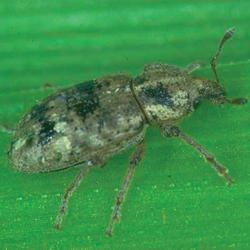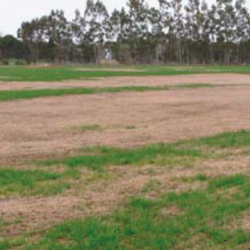Argentine stem weevil (Listronotus bonariensis)
Argentine stem weevil (ASW) is a major predator of ryegrass, maize, cereals and to a lesser extent forage brassica crops during plant establishment. ASW can be found throughout New Zealand and is a potential pest every year with climatic conditions having little effect on populations. A bio-control wasp was introduced in 1990, but its effect has reduced in recent years. ASW is considered one of the most costly pasture pests in New Zealand.
Life cycle
Generally there are two generations per year, one during spring and the other during late summer/early autumn. Adult weevils begin laying eggs in spring as soon as the average daily temperature reaches 10 degrees. Eggs are laid in the sheaths of tillers of the host plants and after hatching the larvae tunnel and feed within plant tillers. Larvae pass through five stages of development before leaving the host plant and pupating to adults in the soil. Young adults commence laying eggs soon after emergence from pupae. Egg laying is controlled by day-length and typically stops around mid-March. Adult weevils can fly and large dispersal flights can take place on calm warm days in summer and autumn.
Identification
The ASW adult is a small hard bodied beetle (2-3mm in length) and grey/brown in colour. The adult weevil is also characterised by three pale stripes on its thorax. The size and non-descript colour makes adult weevil very difficult to see. Larvae are white, growing to 1-5mm in length.
Feeding
Larvae cause the most damage to host plants, mining the stem of vegetative tillers, which wilt and turn yellow from the center outwards. When larvae infestation is heavy, severe damage can be done to the sward, particularly in dry conditions when plants are under stress. Individual larvae can destroy up to eight ryegrass tillers during their development and can move to new plants if required. Adult feeding is characterised by ‘windowing’ of the grass leaf near its tip. Adult and larvae feeding is normally most damaging in the late summer/ early autumn period, which coincides with the pasture sow-down in many regions. Ryegrass seed established ‘grass to grass’ through a no-tillage program or ‘undersown’ into existing pasture is particularly vulnerable to ASW attack, because the existing plant material may be hosting the pest.
Prevention and control
Superstrike grass, Ultrastrike brassica, Gaucho brassica or Poncho maize seed treatment for protection against adults and larvae during plant establishment.
Contact insecticide pre-sowing to reduce adult population, especially under no-tillage.
Use of ryegrass with AR1 endophyte for protection against adults or AR37 endophyte for protection against larvae over the long term.
For more information visit www.agpest.co.nz or www.ar37.co.nz




